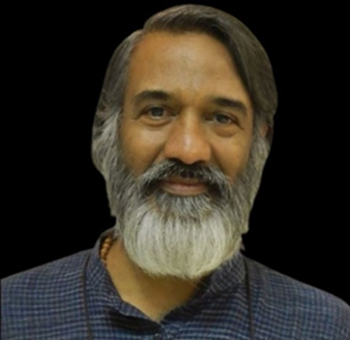.png)

Raghu Ananthanarayanan, founder of Sumedhas Academy, is Chief Consultant at Flame TAO Knoware and an IIT Madras alumnus, advising top firms

Steve Correa, Executive Coach and HR Consultant, brings 30+ years of CXO experience across industries and is the author of Indian Boss At Work.
February 20, 2025 at 5:30 AM IST
If we scrutinise the past carefully, we find it has already dissolved into nothingness. The past exists solely as memories—fading echoes of events and experiences. Similarly, the future holds no tangible reality; it is merely a construct of imagination, filled with projections, possibilities, and uncertainties. But what of the present? When examined deeply, the present also dissolves into an intangible state.
The moment that has passed is gone, and the moment to come has not yet arrived. What remains is the now—a space instantaneously and seamlessly connected to pure potential, a silent emptiness from which all things arise to manifest in transitory reality. Sutra 14 of the 3rd Chapter of Patanjali’s Yoga Sutra states this.
3.14 The characteristics of an object can be dormant, active, or potential, yet there is an essence underlying the object. The dharmī is that which undergoes the transformations in nature.
This realisation is not new. Spiritual traditions worldwide have long emphasised the power of silence and emptiness as the essence of existence. In the Zen tradition, silence is not merely the absence of sound but the presence of all that is. The great Zen masters often taught through silence, conveying the depth of wisdom that words fail to express.
Similarly, in Advaita Vedanta, the ultimate truth—Brahman—is described as neti neti (not this, not that), pointing towards an ineffable emptiness (beyond this and that), transcending conceptual thought. Dakshinamurti is described as a form of Shiva. He is a young and a wise person, who sits in silence. Around him are elders and learned people. Dakshinamurti’s face is illumined; he is fully anchored in the silence of Brahman, and in this profound silence, the doubts of all the elderly seekers get resolved.
Many societies believe life and death are distinct episodes—one marking the beginning and the other signalling the end. Yet, upon closer inspection, life and death emerge as continuous phenomena, with each moment encompassing both birth, dissolution, and rebirth.
The Sanskrit concepts of Gatti and Niyati illustrate this dynamic interplay, where existence flows in an ever-unfolding rhythm, forming and dissolving without fixed boundaries. Observe the world around you: the changing seasons, the tides—how everything seems to follow a circular pattern—emerging, disappearing, and re-emerging. It is worth noting that the sea from which the tides and waves arise is everlasting.
The concept of a perpetual soul—a self that reincarnates across lifetimes—is a misunderstanding of the profound nature of Brahman and ātman. As long as a person is trapped in the mistaken belief that one’s bodily form, emotional experiences, or mental capabilities define one’s existence as distinct from the world in which one lives, one believes that the wave represents the whole self! The notion of an enduring jīvan that is reborn is yet another conceptualisation, another attempt to grasp something beyond form. The Yoga Sutras speak of a quintessence of a person’s “self” that is left behind at death, referring to it as vāsanā. However, vāsanā is not a diminutive version of the person I am now! It is not a spiritual equivalent of the homunculus in one’s brain. Nor is it equivalent to “soul.” It resembles an encrypted code that unfolds when energised by ātmā, just as a wave is the pattern generated by the currents at deeper sea levels.
The mind is patterned and preconditioned to thought. An ordinary mind is filled with ‘Citta vṛtti’. The Yoga Sutra posits that vṛtti (modes of feeling and thinking) are generated by an anxious mind. When beset by anxiety, the mind seeks either to end it or to escape. One’s mind constructs a set of possibilities based on memories of pleasure and pain, shapes interpretation of oneself and the world, and becomes entrenched in conditioned beliefs. Our mind presents projections and transference.
In contrast, an “empty mind”, one in profound silence, śāṃtam, does not signify ignorance or absence but rather the presence of pure awareness. The common adage that an empty mind is the devil’s workshop assumes that silence breeds mischief. However, a deeper perspective suggests that an empty mind is God's workshop—a space where insight arises spontaneously, unblemished by past conditioning or future anxieties.
In silence, the self remains undivided by conflicting forces of desire, fear, or identity. Instead, all aspects of the self achieve harmony. As Carl Jung noted in his exploration of the anima and animus, wholeness arises when the masculine and feminine energies within an individual are integrated. The Yin and the Yang, the Nar and the Nari, dissolve into a unified emptiness where duality ceases to exist, allowing pure human potential to rest quietly. Duality emerges in the presence of anxiety; it manifests when one attributes external causes to their anxiety. The world that is perceived is viewed as separate from oneself, becoming the source of both—the anxiety and its solution. Duality prevails when wholeness is not experienced and embraced.
The collective human mind has long celebrated war heroes who demonstrate strength through destruction. However, this one-sided glorification of aggression (the Rambo image) fractures societies. The modern workplace has adopted concepts from competitive sports and warfare. When ‘disorder’ is tamed by ‘order’ through aggression and penetration, a warrior identity emerges that, when collaboratively embraced, creates a universe of rules and protection. This emergence reflects an excessive engagement with masculine energies—either dominant or passive—alongside the notion that the world is to be conquered. The concept of līlā—play, where there is room for rule-based and enjoyable engagement with the world, is more conducive to a joyous and respectful approach to others and one’s environment. Winning and losing, competing and excelling are temporary phenomena.
As Bob Dylan beautifully sings:
“Come writers and critics
Who prophesise with your pen
And keep your eyes wide
The chance won't come again
And don't speak too soon
For the wheel's still in spin
And there's no tellin' who
That it's namin'
For the loser now
Will be later to win
For the times they are a-changin”
True wholeness is achieved not through dominance, but through integration. When out of balance, a passive woman may be subjugated by societal forces, just as an aggressive man may perpetuate cycles of violence. The key to transcendence lies in balancing these energies, where a woman discovers her inner strength and a man embraces his capacity for vulnerability.
In emptiness, these polarities dissolve. What remains is the whole—a state of being that transcends gender constructs, personal identities, and societal impositions. To become whole is to embrace emptiness, permitting the release of preconceived notions of self and other, strength and weakness, presence and absence.
Emptiness is not merely a void; it is the source of all creation. In Taoism, the Tao is described as the space that gives rise to all things while remaining formless. Similarly, in the Bhagavad Gita, Krishna discusses detachment as the path to true freedom—releasing attachment to outcomes and embracing the vast emptiness in which all action unfolds effortlessly.
Today, the practice of mindfulness, rooted in Buddhist teachings, emphasises cultivating a spacious awareness that allows thoughts and emotions to arise and dissipate without attachment. This practice resonates with a deeper understanding that when the mind is empty, it is free. By embracing silence, one lays the foundation for profound clarity and peace. The Upanishads and the more subtle and profound practices in Yoga enable one to directly perceive one’s ātmā and realise that it is Brahman.
The journey towards understanding silence and emptiness is not about negating life but engaging with it more fully. When we cease to cling to our narratives—our pasts, expectations, and identities—we become open to the vast reality of the present. This realisation is essential for human exchanges to be wholesome and meaningful. The loving and healing encounter of two people, two ātmā enveloped by prāṇa and form, is possible only in profound silence.
This is the paradox and beauty of existence. To be empty is to be full. Emptiness is the source of the whole, which celebrates itself by encountering emptiness. To be silent is to be complete. In embracing nothingness, we find everything.




